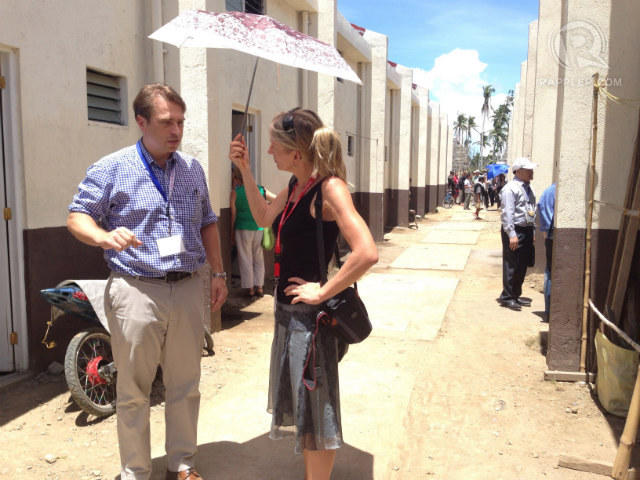SUMMARY
This is AI generated summarization, which may have errors. For context, always refer to the full article.

LEYTE, Philippines – Wearing their uniforms, more or less 50 students waved improvised Philippine flags Wednesday, June 4, to greet international delegates visiting their school in Tanauan, Leyte, badly damaged by Super Typhoon Yolanda (Haiyan) in 2013.
Delegates at the Asia Europe Meeting (ASEM) Manila Conference on Disaster Risk Reduction and Management met these students in the Bislig Elementary School on Wednesday morning. (Get updates on the conference Thursday from Rappler: LIVE: ASEM on Disaster Risk Reduction and Management)
The ASEM delegates went there to unveil their pledge: a computer classroom to help Bislig Elementary School, which was among Leyte’s top performers before Yolanda devastated the Eastern Visayas region.
“We thought that ASEM can give a concrete part and contribution to the people on the ground, to make the ASEM conference relevant to the lives of the people,” said the conference chairperson, Maria Zeneida Angara Collinson.
Collinson, assistant secretary for European Affairs of the Philippine Department of Foreign Affairs, also said: “We want them to feel and know that there is a lot of sympathy and a lot of solidarity out there, and that everywhere, not just in the Philippines, but overseas, there is respect for the resiliency of the people of the Philippines and especially Bislig.”
A Philippine initiative, the ASEM Manila involves senior representatives from international governments, organizations, and the private sector.
These dignitaries will meet in Manila from Thursday, June 5, to Friday, June 6, to talk about disasters and sign the Tacloban Declaration, which is seen to include new principles in disaster risk reduction and management.
‘I pity them’
Before their meetings in Manila, the ASEM delegates saw the problems on the ground after Yolanda.
One of the students who greeted them was Jasmin Espinosa, 12 years old.
Like millions of other students, she returned to school on Monday, June 2. Unlike most students her age, however, she spent the first day of school in a make-shift classroom.
To add to her heavy feeling, she said her classmates failed to make it to school.
Espinosa said her classmates don’t have money to pay certain school fees. She even saw parents begging teachers to take their children in.
“Naaawa po ako,” she said. (I pity them.)
She appealed to the government, “Gusto ko pong matulungan sila para makapag-aral at makapagtrabaho.” (I want them to be helped so they can study and work.)
Homeless, jobless survivors
The ASEM delegates saw other problems outside the school.
For one, many Yolanda survivors remain homeless and jobless.
Coming from Bislig Elementary School, the other thing ASEM delegates saw was a set of permanent shelters built by Gawad Kalinga, a non-governmental organization, and the National Housing Authority.
Conference organizers said 40 families from Barangay San Roque, a fishing community, live in the resettlement project in Barangay Pago in Tanauan, Leyte.
The good thing is, they have permanent houses.
The bad thing, according to residents, is that they live far away from their fishing village.
The government relocated them, they said, to reduce the risks in times of disaster.
‘The house is OK but…’
Jun Roble, a 50-year-old fisherman, said he is happy he has a permanent home to live in, but pointed out the things they still need: electricity, water, and most importantly, materials for fishing.
“Okay lang ang bahay kaya lang wala kaming hanapbuhay dito. Mahirap,” said Josephine Villegas, 36, the wife of a fisherman. (The house is fine but we don’t have a house here. It’s difficult.)
It doesn’t help that her husband spends P20 for his two-way tricycle fare to Barangay San Roque, when he earns only P200 a day. On top of that, he spends P80 on fuel.
If rice wasn’t given as relief goods, they could only save P55 a day. (They get their viands for free – the fish they catch in the sea.)
“Sana magkaroon kami ng permanente naming hanapbuhay,” she said. (I hope we can have a permanent source of income.)
Kristalina Georgieva, the European commissioner for international cooperation, humanitarian aid, and crisis response said in Leyte, “We cannot possibly continue with business as usual.” – Rappler.com
Add a comment
How does this make you feel?
There are no comments yet. Add your comment to start the conversation.